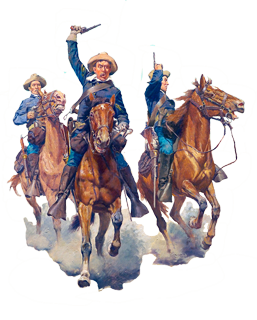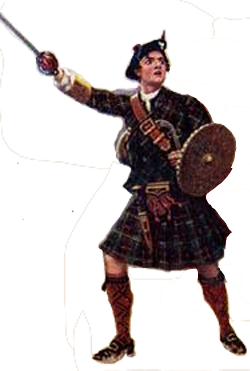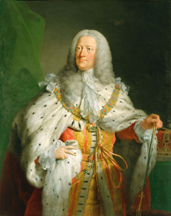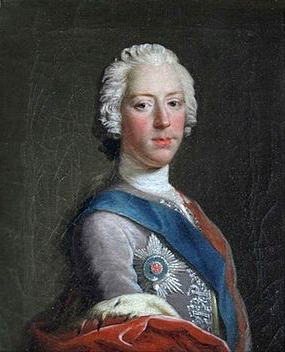






This is a picture of me and my mother taken long ago and far away. Way back then, in the British Isles, street photographers would take your picture, often whether you wanted them to or not. They hoped you would buy the photograph. Obviously, my mother did buy it, likely because of the handsome and irresistible fellow on her arm.
 First I must say, and I know this will come as a shock, but no such encounter took place between the United States Cavalry and the Scottish Highlanders either in 1956 or any other year. Also, in 1956, February did not have thirty days. As to the credits, the painting of the cavalry is better known as Cavalry Charge on the Southern Plains in 1860 by Frederic Remington. Since Mr. Remington left us long ago at too early an age, his painting is no longer under copyright. The painting of the Highlanders appears to be a modern illustration, but try as I might, I could not locate the name of the artist, so I suppose I will have to wait until I am sued or threatened in order to know his or her identity. And since no one but me will probably ever look at this page that will likely never happen. Oh, the picture frame, which I have so grossly and amateurishly distorted, comes courtesy of Krzysztof (Kriss) Szkurlatowski and www.freeimages.com.
First I must say, and I know this will come as a shock, but no such encounter took place between the United States Cavalry and the Scottish Highlanders either in 1956 or any other year. Also, in 1956, February did not have thirty days. As to the credits, the painting of the cavalry is better known as Cavalry Charge on the Southern Plains in 1860 by Frederic Remington. Since Mr. Remington left us long ago at too early an age, his painting is no longer under copyright. The painting of the Highlanders appears to be a modern illustration, but try as I might, I could not locate the name of the artist, so I suppose I will have to wait until I am sued or threatened in order to know his or her identity. And since no one but me will probably ever look at this page that will likely never happen. Oh, the picture frame, which I have so grossly and amateurishly distorted, comes courtesy of Krzysztof (Kriss) Szkurlatowski and www.freeimages.com.
If you’re really interested in this sort of thing, the illustration of the Highlanders supposedly depicts the Battle of Prestonpans. While Prestonpans may sound like a brand name for stainless steel cookware, and seems like it should be written Prestonpans™, it was an actual battle that took place in 1745, at 4 am on the 21st of September, which seems like a horrible time to get up and fight a battle.
It was fought between the Highlanders supporting Bonnie Prince Charlie and the government forces of King George II. It is reported that the government troops broke and ran. It is likely that they didn’t understand that Highlanders wore kilts and thought they were being attacked by a bunch of crazed women who were heavily armed and quite ugly. And remember, it was four in the morning.
A lot of Americans misunderstand that whole conflict between Charlie and George, and even more Scots misunderstan d it, so I should take a few minutes to clarify everything.
d it, so I should take a few minutes to clarify everything.
You see, the king that ruled Britain was George II. George the Second was German. You might think because his father, George the first had been King of Britain before him that George II wouldn’t be so German, but it didn’t work out that way. I think when Daddy went to be King of England that little Georgie stayed behind in Germany. Little Georgie, who was about thirty-one at the time, did remain in Hanover (which is in Germany) and didn’t learn English. At least, I don’t think he learned English. I’ve also heard he wasn’t very nice to his wife, or Frau.
Now Bonnie Prince Charlie, who is also known as Charles Edward Louis John Casimir Sylvester Severino Maria Stuart, or The Young Pretender, or as I like to call him, Casimir, was not German. He was one half Polish, but he was born and grew up in Italy. He did have a wee bit o’ Scotch in him. Actually, he was less than one sixteenth Scottish. But as a young man, Charles decided that even if he was only one sixteenth Scottish that God had made him king of Scotland. In fact, he seemingly was convinced that God had made him king of Great Britain, and that being the case, the only respectable thing for him to do was go to Britain and claim the throne. His father was still alive at the time, but seemed to feel that if his son Charlie could get the throne of Britain, then good luck to him.
Catching a ride on a French warship, Charlie had them drop him off in the Western Isles which are west of the Highlands of Scotland and thus filled with Highlanders whom he felt would be more sympathetic to his cause. When he told the Highlanders that he intended to march south to London and take over, they said “That will never work.” But he was a young man of 24 and forever optimistic. When they demurred and didn’t think marching on London a good idea, the ever positive Charlie told them if they wouldn’t go with him he would go alone.
 He might have taken off alone at that point, casting glances behind him to see if anyone was following, if it weren’t for another young man who was even more impetuous than Charlie. “I’ll go with you,” he yelled. What followed was like one of these old movies from the 1930s. You know the ones. After a pregnant pause where no one is with the hero, finally someone says “I’ll go” and then another says he’ll go and more and more, until the hero is marching and grinning and leading a whole bunch of guys while singing some lame song about Captain Somebody’s infantry.
He might have taken off alone at that point, casting glances behind him to see if anyone was following, if it weren’t for another young man who was even more impetuous than Charlie. “I’ll go with you,” he yelled. What followed was like one of these old movies from the 1930s. You know the ones. After a pregnant pause where no one is with the hero, finally someone says “I’ll go” and then another says he’ll go and more and more, until the hero is marching and grinning and leading a whole bunch of guys while singing some lame song about Captain Somebody’s infantry.
Something else we need to get straight. A lot of Americans think that what occurred in the rebellion of 1745 was a war between the Scots and the English. Even textbooks in the United States at times make this claim, but nothing could be further from the truth. Well, actually, there are a lot of things that could be further from the truth but they’re not really involved here.
But where do Americans get this very erroneous idea? They get it from the Scots. The Scots are really great people in my unbiased opinion, but you’ve got to watch what they say when they are drunk or sentimental or both. About fifty years after the Forty-five as the Scots call it, Scotland entered into the Scottish romantic period, where many Scots changed their opinion of Charlie. You have to understand something about the Scots. They may not like you. They may disapprove of everything you do. They may even want to destroy you, but that doesn’t mean that after some time passes they won’t turn you into a romantic, beloved hero.
They did this with Mary, Queen of Scots. They became quite upset with her, because they felt she had a bad attitude, and so they drove her out of Scotland. She fled to England, which was a very bad idea, but that’s another story. The point is that she would become a national heroine when the Scottish romantic period dawned. Likewise with Bonnie Prince Charlie. When he announced that God had sent him as their king, the Scots were of the opinion that the only king God had sent was Jesus, so they fought against Charlie and helped dispatch him, but fifty or sixty years later he became a national hero.
The only people who ever supported Charlie were some, but not all, of the Highlanders. The majority of the people of Scotland opposed him and when necessary they fought against him.
But at first they did nothing. And as a matter of fact, Charlie did nothing either. He dilly-dallied for a while in the Scottish capitol of Edinburgh, before finally deciding to plunge down into England and head for London. But he was finally driven back by a phantom army. I don’t mean an army of ghosties and ghoulies, but by an army that didn’t exist even though he thought it did.

It all ended very tragically on a Scottish moor, in a fight that has become legendary and is known as The Battle of Culloden. Charles insisted on leading the battle while behind the lines where he couldn’t even see what was happening. His arrogance led to a terrible defeat. He fled to the continent where he abused alcohol, his wife who eventually left him, and his mistress who escaped him with help from his own father. And then fifty or so years later he became something of a national hero and has continued as such to this day.
The man that led the army that defeated Charles, William Augustus, Duke of Cumberland, was at first lauded by some of the Scots, but history has not been kind to him. He has come to be reviled both in Scotland and in England, because of atrocities he is accused of, both on the battlefield and in the months after the battle.
Now that you’re thoroughly depressed let’s talk of something else. Do you know, if you go to Scotland, under the right conditions and at the right time of day, you can spot herds of unicorns gamboling in the meadows? When I have time I will explain just how this is done, but unfortunately I have to go now.
Home Page Credits
Photograph of our hero and his mother: Late 1940s taken by an unknown street photographer.
Collage of: Battle of Prestonpans, by an unknown artist. Date unknown.
The Cavalry Charge, by Frederic Sackrider Remington (1861-1909)
An interesting point about my slightly fictional battle between the U.S. Cavalry and the Scottish Highlanders in 1956, is that the last authentic U.S Cavalry charge occurred on January 1942, when the U.S. 26th Cavalry Regiment successfully charged the Japanese infantry near the village of Morong in the Philippines. How about that.
Paul Cherry Memorial Page
Photo of Paul is modified from a photograph which is the propery of David Cherry.
Picture with poem was created using a photograph by Zoan of Sofia, Bulgaria.
The poem in the picture "Do not stand at my grave and weep" is attributed to Mary Elizabeth Frye in 1932. The font is a proprietary font.
Credits and Comments Page (This page.)
Detail from Cavalry Charge 1905 by Charles Schreyvogel (1861-1912)
Highlander from Battle of Prestonpans by unknown artist, date unknown
Culloden Panorama 2007 anonymous
Elijah Page
Elijah from Jezabel and Ahab Meeting Elijah in Naboth's Vineyard by Sir Francis Dicksee
Scan of Psalm 83:18 & 9:1, 2 from The Holy Bible Anno Dom. 1611, commonly called the Authorized Version in the U.K. and the King James Version in the U.S.A.
The Great Opera Composer Page
Sullivan from Punch 30 October 1880 by Edward Linley Sambourne (1844-1910)
Pied Piper by Kate Greenaway (1846–1901)
Wagner Hand-colored Engraving by André Gill
Legendary History of the Scots Page
El sueño de Jacob (Jacob's Dream) 1639 José de Ribera (1591–1652) Prado Museum
Jacob's Vision and God's Promise 1906 by the Providence Lithograph Company
Jacob's ladder James Tissot (1836–1902)
Author's page
top left is me in my Grizzly Adams persona picture taken by Louise
Upper right: A picture of W. Shakespeare signed by the author to me
The covers of my three books
George Washington Page
Washington cameo from George Washington by Gilbert Stuart c1798
Columbia from World War I recruitment poster painted by V. Aderente
Hail Columbia, 1789, Music by Philip Phile, Words by Joseph Hopkinson
Northern Flight Page
Extracted and colored from John Tenniel`s original (1865) illustration for Lewis Carroll`s "Alice in Wonderland". Alice sitting between Gryphon and Mock turtle
Walrus and Carpenter 1871 John Tenniel colored
Cover of Northern Flight 1987 All rights reserved
Judith with the Head of Holofernes 1613 by Cristofano Allori(1577-1621) (Holofernes head was a self portrait of artist but does not appear in this cropped image)
Final Word page
Top left, is the title page of the Holy Bible A.D. 1611.
Top right, and at the bottom of the page: the Scottish Coat of Arms with the injunction of Revelation 22:18 & 19.
Email: contact@ericaitken.com
© Copyright 2015 Eric Aitken All rights reserved.